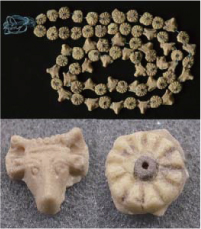Archaeological and chemical analysis of ancient necklaces

Polyester is a chemical fiber frequently used in the production of modern-day clothing. It was invented as a substitute for expensive natural fibers such as silk and cotton, which have been used to make cloth since ancient times. People often use inexpensive and more accessible materials in place of more precious ones.
Tokai University’s collection of ancient Egyptian artifacts includes two necklaces made of yellow beads. There are two types of beads: one represents the goddess Hathor, the ancient Egyptian cow-headed goddess of motherhood, and the other represents a flower. The latter beads are round and about 1.2 cm in diameter, and are embedded with small, round, dark blue beads (though the colors have faded) that represent flower pistils. Although the necklaces are now single-string types, it is not certain how they would have looked when they were uncovered.
Kyoko Yamahana, an associate professor in archeology, and Yasunobu Akiyama, a professor in chemistry, have been collaborating on research into these yellow beads. Professor Akiyama used X-rays to analyze the beads and found that they are made from sulfur. Ancient Egyptians often used stone, animal bone, metal, and glass to make necklaces, but rarely used sulfur. Sulfur can be found in the vicinity of Cairo. It is a friable substance, which means it is easy to manipulate. It also melts at temperatures that can be reached in a bonfire. Professor Akiyama used computational analysis to show that all of the Hathor beads were mass produced using between one and three molds, which suggests that they were all made in a single place. The small, dark blue beads in the centers of the flower beads were made of a substance known as “Egyptian faience”*. The techniques used to make that material are no longer known.
Professor Yamahana tentatively dates the necklaces as having been made between the 3rd century BC and the 2nd century AD. She believes that they may have been created for use as burial goods, because in ancient Egyptian stories, yellow represented the skin of the gods and dark blue represented their hair.
We find something similar in coffins used to house the bodies of pharaohs. Many of them were covered in precious gold and decorated in stripes of lapis lazuli. Perhaps the ancient Egyptians were attempting to use sulfur as a substitute for gold, and Egyptian faience as a substitute for dark blue lapis lazuli.
*Egyptian faience: A type of ceramic made using sintered quartz.

山花京子准教授(東海大学文化社会学部アジア学科)
専門は古代エジプト考古学。ファイアンスの研究の第一人者。著書『悠久のナイル: ファラオと民の歴史』は、東海大学の古代エジプトコレクションの図録。

秋山泰伸教授(東海大学工学部応用化学科)
専門は基礎化学、材料工学、プロセス工学。化学に関する専門書の他に、電卓登場前後の計算道具を紹介した『愛しの昭和の計算道具』等、著書多数。
東海大学古代エジプトおよび中近東コレクション
古代エジプト及び中近東のコレクション約6,000点がデジタルアーカイブ化され、オンライン公開されている。材質・時代・地域・年代で検索できる。
アクセスしてみよう
アクセスしてみよう
このRESEARCHに関連するリンク